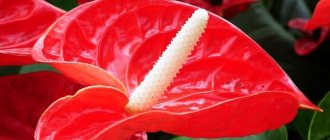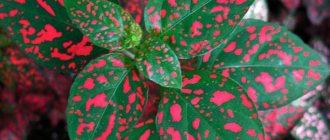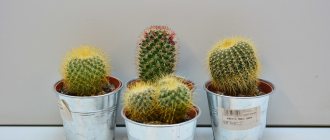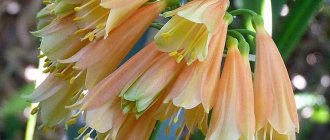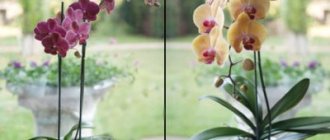Guzmania is a spectacular and bright plant, despite its not very sonorous “name”. By the way, this indoor flower received its name in honor of the discoverer, a Spaniard named Guzman.
This 19th century biologist discovered an unusual flower in the American tropics, was fascinated by its bloom and decided to try to move the find closer to people.
Now Guzmania decorates not only summer gardens and famous flower beds, but also home window sills. And people who often grow such plants began to notice its positive effect on their well-being and home environment. Thus, over the years of its presence next to people, guzmania has already managed to gain popularity and has become “overgrown” with signs and superstitions.
What does the plant look like?
As is typical for epiphytes, the roots of this flower crop are not very strong. Under natural conditions, they serve as an attachment to the bark of a tree or rocky surface.
There is no stem as such. Narrow long green leaves are pressed tightly to the base, rising upward and forming a high rosette. The leaves of the peduncle at the top of the rosette are the usual scarlet color, however, hybrid varieties provide a wide choice of color combinations.
Different types and varieties of crops differ in the height, width and length of green leaves, the shape and color of the bract, as well as its height (from 40 to 70 cm).
Reproduction of Guzmania
Most often it reproduces by lateral shoots, less often by seeds.
Reproduction by shoots
After flowering, the rosette gradually dies, while forming lateral shoots from renewal buds. After about 2 months, the young rosettes develop several leaves and weak roots. At this time, they are carefully separated from the mother plant and placed in separate pots, covered with polyethylene or glass. Kept at a temperature of 26-28 degrees.
Growing from seeds
The seeds are scattered over the surface of the soil consisting of equal parts of peat and sand. The container is covered with glass or polyethylene and placed in a well-lit, warm (23-25 degrees) place. The “greenhouse” is regularly ventilated and the soil is sprayed.
Shoots should appear in 2-3 weeks. After 2 months they pick up, and after another six months they are seated in separate pots.
Is it good or bad to keep a flower at home?
Guzmania was found in the tropics of America and immediately attracted attention with its charming appearance. For this reason, people started trying to grow it in their gardens and homes.
It is true that guzmania blooms only once in its entire life, but it is incredibly beautiful and long-lasting (up to 4 months). Now the choice of hybrid varieties is large: you can find specimens not only with scarlet, but also with orange, yellow, burgundy and pink rosettes.
INTERESTING! The tops of the rosettes are not actually inflorescences, but just modified foliage: its bright color is needed to attract the attention of pollinating insects.
Signs claim that the culture has disinfecting properties, which, without a doubt, will have a great effect on the quality of the surrounding air. The thing is that flowering is accompanied by the release of substances with bactericidal properties. Thus, culture will help you reduce the concentration of pathogenic microbes at home.
Symbol of male longevity - guzmania flower
Under the canopy of tropical forests in Central and South America you can see rosettes of lush green foliage, above which rise bright red, yellow and orange plumes - this is guzmania. Plants, named after A. Guzman, a famous traveler and naturalist from Spain, settle on fertile soil under the crowns of plants, lead the lifestyle of epiphytes, climbing roots and branches, and are found on open slopes.
Guzmanias, which are closely related to pineapples, belong to the Bromeliad family.
Plants differ among themselves in size, foliage color and lifestyle. Moreover, among the 120–130 species of these herbaceous evergreens, there are many varieties chosen by gardeners for keeping and growing indoors.
What are the features of the flower? What does Guzmania bring into the home, and what is it about it that attracts the attention of flower growers around the world?
Signs and superstitions about Guzmania for men
According to the superstitions of the places where this plant comes from, it is considered the embodiment of male power. Therefore, it is believed that it helps to activate the vital forces of the male sex, promotes longevity and improves the condition of men in the physical and spiritual aspects.
According to signs, if a man is alone in the house, then Guzmania will definitely contribute to success on the personal front.
There is also such a superstition: if a man is already in a relationship, then they will become more passionate and begin to actively develop, bringing positive emotions.
Problems during cultivation
Some of those who grow this flower are faced with the problem that flowers do not appear on it. Why does guzmania not bloom, what could be the reason for this? This usually happens because the flower is not cared for correctly. Why doesn't this plant bloom? For several reasons:
- there are drafts in the room;
- the flower is negatively affected by temperature changes;
- lighting in the room is insufficient;
- improper hydration;
- insufficient feeding.
In order for the flowering to last for a long time, you need to provide the guzmania with bright light, but it is necessary to shade the flower from direct sunlight. Before the plant must bloom, the temperature in the room must be high, 25 degrees or more. And only when the plant has bloomed can the temperature be reduced. It loves high air humidity, as it grows in tropical forests. When shoots and leaves begin to appear on it, they must be sprayed every day. It is also necessary to adjust watering, which should preferably be done in a rosette of leaves. On hot summer days, for abundant flowering, there should always be water in the funnel, and the roots should be watered to a minimum. For beautiful, long-lasting flowering, suitable soil is also important. The flower feels good in loose, breathable soil. It is advisable to grow guzmania in a mixture of small fern roots, sphagnum, peat, river sand and charcoal. Some people purchase special soil at a flower shop. During the flowering period, the plant needs to be fed once every 10 days; thanks to universal fertilizers, the flowering period can be significantly extended. Another condition for flowering is regular replanting once every couple of years in spring or summer. So, the one who gets a guzmania gets an attractive, exotic resident on the windowsill, which symbolizes male strength, improves mood, performance, well-being and family relationships.
Why does Guzmania bloom?
Guzmania typically blooms in autumn. If it begins to bloom at another time of the year, then according to signs and superstitions, this does not indicate the most pleasant things. Superstition says that unscheduled flowering is a symbol of a tense situation within the family. One of the reasons may be the spouses' passion for outside relationships.
According to signs, a flower that is healthy and blooms in autumn reflects the well-being of the family and home environment.
Signs also indicate that happy relationships, a friendly atmosphere and mutual understanding - all this has a beneficial effect on flowering.
Diseases and pests
The plant is quite resistant to diseases and pests. However, if not properly cared for, problems may arise:
- The tips of the leaves dry out - low air humidity.
- Root rot is caused by excess moisture in the soil.
- leaves wither - low temperature.
- Gray spots on the leaves are a fungal disease.
- White limescale on the leaves - watering and spraying with hard water.
- It has bloomed, but the children do not appear - there is a lack of nutrients (maybe if you don’t cut off the wilted peduncle).
- Spots on the leaves of a pale brown color are burns due to direct sunlight.
Pests that may threaten are scale insects, spider mites, and mealybugs.
Feng Shui meaning of Guzmania
The ancient Chinese wisdom of Feng Shui says that guzmania can greatly help those who shelter it in their home:
- Admiring the appearance will give you a feeling of calm and inner harmony;
- Guzmania will bring harmony to the couple’s intimate relationships and reveal their sensuality;
- In a duet with green plants it will promote development in the professional field;
- A specimen with yellow inflorescences will attract prosperity and fortune to the house.
REFERENCE! According to superstition, the energy of red or orange guzmania will be very appropriate in the Aries house: it will complement the owner and support his desires and aspirations.
Caring for Guzmania at home. Details
The plant requires quite careful care. However, if you provide it with the necessary conditions, it will delight you with decorative foliage and luxurious flowering for a long time.
Bloom
Guzmania blooms only once in the second or third year of life . A spike-shaped inflorescence of inconspicuous white flowers is surrounded by bright leaves-bracts. They are what give the plant its spectacular appearance. Their color can be red, yellow, orange or pink.
Flowering duration is 3-5 months. To prolong it, do not allow water to get on the flowers and perianths. After flowering, the rosette gradually dies off.
Temperature
The plant is thermophilic. In summer, the optimal temperature for it is 20-25 degrees, but not higher than 28; in winter – 18-20 degrees. It is undesirable to lower the thermometer below 15 degrees: the flower may get sick and will not bloom.
The plant should be protected from drafts and sudden temperature changes during ventilation in winter.
Spraying
Homemade guzmania loves high environmental humidity, ideally 60-85%. The plant needs daily spraying with distilled or filtered water. During the flowering period, drops should not fall on flowers and bracts.
Can a flower be dangerous?
Just as guzmania enhances all positive energy in the home, it can do the same with negative emotions:
- if you are experiencing discomfort at home, do not want to return, feel out of place and may even be thinking about moving, then these are negative signs that the guzmania flower makes you feel;
- if people are prone to aggression, anxiety, and often get angry, then according to superstition, flower culture will lead to a multiple exaggeration of the manifestation of these feelings;
- They believe that guzmania is a magnet for uninvited visitors and even ill-wishers, however, it only has this effect on closed and unfriendly hosts.
What benefits does a flower bring?
The benefits can be assessed from different points of view: both everyday and esoteric. Guzmania is believed to:
- Cleans and refreshes the air, destroying bacteria and negative energy.
- Normalizes balance, brings harmony and sets the people around her in a positive mood.
- Gives creative strength, increases inspiration.
Thus, just one plant (subject to high-quality care for it) allows a house to turn from an ordinary home into a cozy nest in which it is easy to live and create.
Where is the best place to put a flower?
To improve relationships in all directions, spouses are recommended to place a pot of guzmania in the bedroom, but under one condition: there must be two plants. They say that in the bedroom all objects should be paired, which will personify the well-being of each of the couple. It is also recommended to place plants opposite each other.
Another good place for Guzmania would be the south-eastern space of your house or apartment, as this is the area of love and marriage. The eastern zone is responsible for the development and health of residents, where it will also perform well.
When guzmania fades with photo
No matter how beautiful the flowering of guzmania is, it ends closer to autumn. The flower gradually begins to turn pale and dry out. During this period, the plant no longer needs either increased watering or fertilizing. How to care for guzmania after flowering? Follow these three recommendations.
- Cut off the peduncle.
- Moisten the pan periodically, but do not pour water into the outlet.
- Gradually remove drying foliage.
When the plant is almost completely dry, daughter shoots will form. It is impossible to revive an old plant. After flowering it dies. New guzmania can be obtained from daughter shoots.
Stimulation of flowering
The plant blooms in spring and summer. The first flowering occurs in the fourth year of life.
If the plant does not bloom for a longer period of time, flowering can be stimulated. To do this, the guzmania is closed with a plastic bag, in which 3-4 apples are placed and tied. Apples release ethylene into the air, which will stimulate flowering. The duration of stimulation is 10 days. The package should not be exposed to direct sunlight. It must be ventilated daily. Apples must be free of rotten spots.
The transplantation procedure is carried out when the plant is propagated. To do this, you need to choose a suitable pot and soil. Guzmania roots do not need a deep pot. They should be tightly placed in the container with the substrate. For greater stability, the container can be placed in a ceramic pot.
The substrate must be permeable, with an acidity of 5.5 to 7.0. Here is an example of one of the substrates acceptable for Guzmania:
Features of care
Since Guzmania is a tropical epiphyte, its cultivation requires special conditions. This primarily concerns air temperature and humidity. For the normal functioning of a plant, diffused light, a certain air temperature at different periods of life and humidified air are necessary.
So, during the period of preparation for flowering, the plant needs to be warm, not lower than 25 ºC. During flowering, it requires an air temperature of about 20 ºC. Despite being thermophilic, constant heat above 25 ºC can lead to the death of the plant.
High air humidity is one of the essential conditions for the life of Guzmania. To do this, the plant is sprayed daily with filtered water, trying not to get it on the bracts. It is recommended to carry out the spraying procedure in the morning. Let's look at how guzmania responds to care at home.
When watering the epiphyte, the following rules must be strictly followed:
Attention! When showering and spraying a flower, water should not be poured on the bracts, as this shortens the flowering time.
Guzmania is fed with special fertilizers for Bromeliads. They should not contain impurities of copper and boron, which are toxic to the plant. Feeding is carried out from March to September. Fertilizers are used in liquid form during irrigation. The frequency of fertilizing is once a month.
